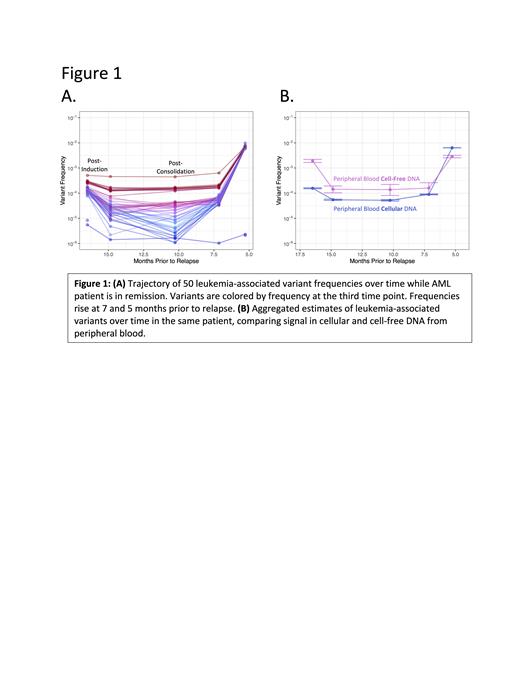Background: Acute myeloid leukemia (AML) is the most common leukemia in adults. While therapeutic options for AML have continued to improve, nearly half of all patients who achieve clinical remission will relapse within several years after diagnosis. Risk factors for relapse include age, cytogenetics, specific gene mutations, and the detection of residual disease after treatment. Current molecular approaches for measuring residual disease are designed primarily around a single gene. This limits both the sensitivity and the applicability of the assay to all patients, as AML is a highly heterogenous genetic disease.
In this study, we demonstrate the utility of a comprehensive, personalized, multiplexed genomic assay that exhibits high sensitivity, excellent quantitation, and promising performance across tissue types. This approach enables the serial, non-invasive monitoring of patients with AML and the prediction of patient outcome.
Methods: Serial samples of bone marrow, peripheral blood, and urine were collected at multiple time points from 12 patients with AML who were treated with standard-of-care therapy. Time points range from presentation to relapse, with a median of 4 time points per patient (range of 2-10). A median of 7 samples were collected per patient (range of 2 to 16). DNA was extracted from the peripheral blood mononuclear cells (PBMCs), the cell-free fraction of peripheral blood, bone marrow mononuclear cells, and the cell-free fraction of urine.
Deep whole genome sequencing of paired presentation and remission samples identified hundreds of candidate leukemia-associated somatic single-nucleotide variants comprising the personalized genomic fingerprint of each patient's disease. A representative set of variants (n=30-50) was selected for each patient, and a personalized set of primers was designed for the Multiplex Accurate Sensitive Quantification (MASQ) next-generation sequencing protocol. The sensitivity of this assay allows for single variants to be quantified down to at least 1 in 100,000, resulting in an overall sensitivity below 1 in 1 million for residual disease detection. Quantification of the individual variants from the fingerprint was evaluated in samples of all tissue types collected (bone marrow, blood cells, blood cell-free DNA, and urine cell-free DNA) and all time points collected (presentation, post-induction, post-consolidation, and follow-up visits).
Results: Serial monitoring of the leukemia genomic fingerprint enables risk assessment after each stage of treatment. Using Multiplex Accurate Sensitive Quantification (MASQ), we detected leukemia-associated variants in the blood and bone marrow of all patients during remission, at levels ranging from less than 10^-6 to 10^-2. We find consistent low signal, less than 10^-4, in both bone marrow and blood in patients with good prognosis. In contrast, we find high signal in remission, greater than 10^-3, in patients with poor prognosis. In the analysis of serial samples, frequencies drop over time with additional treatment and increase preceding clinical identification of relapse. Figure 1A shows the trajectory of 50 variants over 5 time points in PBMCs, preceding relapse. The overall signal increases at 7 months prior to clinical relapse and again at 5 months prior to clinical relapse. Figure 1B shows a comparison of the aggregate estimates of the leukemia genomic fingerprint in the cellular and cell-free components of the blood.
While total DNA yields from the cell-free fraction of blood are lower than from PBMCs, we find that the frequency of the leukemia genomic fingerprint in the two sources of DNA is highly similar. Bone marrow and peripheral blood also show highly similar measurements of residual disease, suggesting that non-invasive monitoring with only a blood draw is a promising approach. Signal of the leukemia fingerprint is also detectable in urine, but at reduced levels and much more variable across patients.
Conclusion: Our study shows the capability and utility of a personalized genomic residual disease detection method using MASQ to monitor patients and predict patient outcome. The high sensitivity and accurate quantitation of MASQ are demonstrated in a case study where relapse could be detected molecularly 7 months prior to clinical identification. Collection and analysis of a larger case series is ongoing.
Disclosures
No relevant conflicts of interest to declare.


